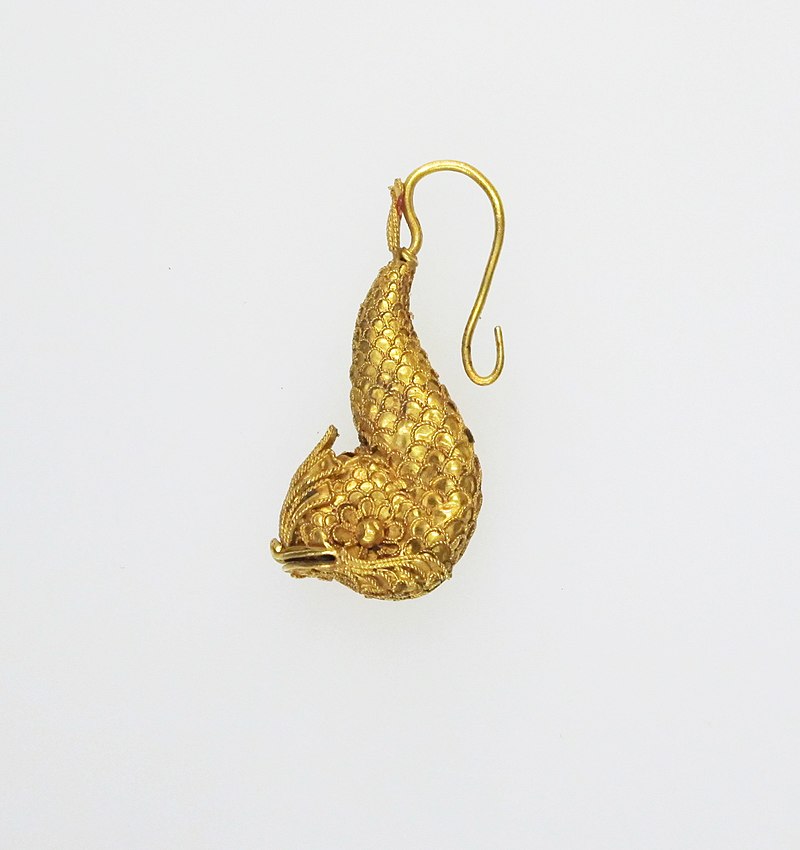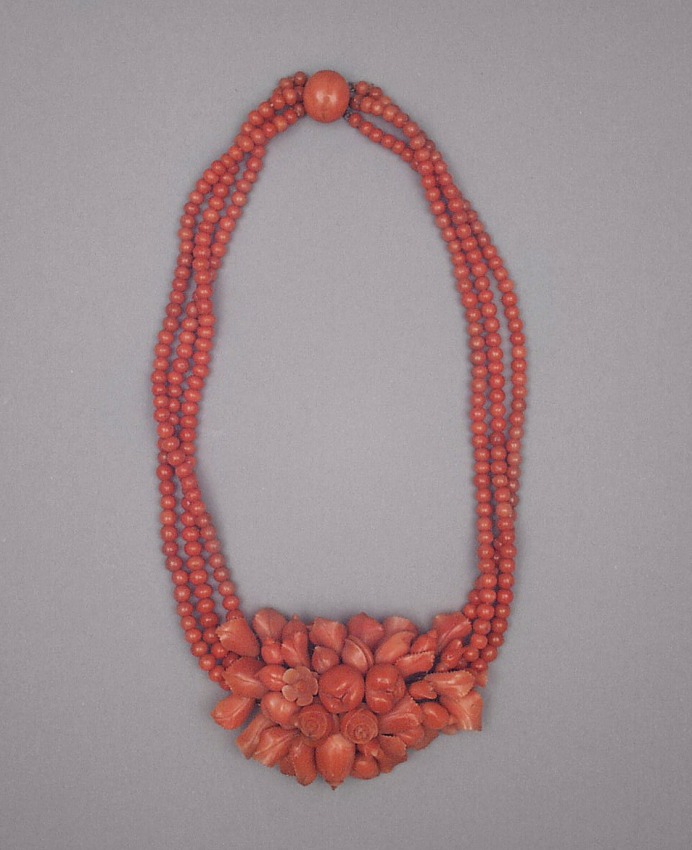
A Venetian courtesan at her dressing table wearing fashionable pearl jewelry of the era. Unidentified painter, c. 1600
Picturesque little towns, turquoise-clear waters, and calming landscapes that fill you with some inner calm are just some of the reasons why the Adriatic Sea has been a source of inspiration for artists and artisans throughout history. The appeal of this aquatic setting, surrounded by diverse cultures and ancient civilizations, has manifested itself in various forms of art, with jewelry being no exception.
Throughout history, a variety of materials have been used to create jewelry inspired by the Adriatic Sea. These materials often reflected the cultural, economic, and artistic influences of their respective eras.
Ancient Greece: The Grace of Dolphins
Dating back to ancient times, jewelry crafted in the Adriatic region reflected the rich cultural tapestry woven by civilizations such as the Greeks, Romans, Illyrians, and Byzantines. Intricate designs featuring symbols of the sea, such as fish, seashells, and dolphins, were prevalent in these early adornments. Gold, often associated with divine attributes, was a favored material, symbolizing the wealth and prosperity of these ancient societies.

In Ancient Greece, artisans crafted exquisite gold bracelets adorned with intricately detailed dolphin motifs. Dolphins, being a symbol of protection and good luck, were a common theme in jewelry. The fluidity of the dolphin designs reflected the graceful movements of these creatures in the Adriatic waters.
Roman Craftsmanship: Amphorae Pendant
The Roman era left an indelible mark on Adriatic-inspired jewelry. Amphorae-shaped pendants, depicting the iconic vessels used for transporting goods across the sea, were a popular motif. Intricately crafted cameos and intaglios featured scenes of maritime life, capturing the essence of daily activities along the Adriatic coast.

Gold was a favored material in ancient times, symbolizing wealth and prosperity. Silver was also used, particularly in regions where gold was less abundant. Gemstones were used to add color and significance to jewelry. Turquoise, with its hues reminiscent of the Adriatic Sea waters, was popular during the Roman era. Other stones like pearls, amethysts, and garnets were also incorporated into designs.
During the Roman era, a popular trend emerged with the creation of pendants shaped like amphorae – the iconic vessels used for storing and transporting goods across the Adriatic. These pendants, often made of gold or bronze, showcased the craftsmanship of Roman goldsmiths and served as a nod to the seafaring culture of the time.
Byzantine Splendor
The Byzantine Empire, with its capital in Constantinople (modern-day Istanbul), exerted a profound influence on the Adriatic region. Byzantine jewelry often showcased intricate filigree work and cloisonné enamel, mimicking the vibrant colors of the sea and the diverse marine life.

Enamel, with its vibrant colors, was applied to enhance the visual appeal of the pieces, capturing the essence of the Adriatic’s ever-changing colors. Religious symbols, such as crosses and icons, were prevalent in Byzantine-inspired jewelry, reflecting the strong influence of Christianity in the region.
The Byzantine influence on Adriatic-inspired jewelry is evident in the creation of exquisite necklaces featuring filigree crosses adorned with vibrant enamel that reflected the diversity of colors of the Adriatic Sea.
The Elegance of Venetian Glass
The Renaissance witnessed a revival of interest in classical art and culture, and the Adriatic continued to be a muse for jewelry artisans. Venetian glass, renowned for its exquisite craftsmanship, found its way into jewelry design, with vibrant hues reminiscent of the sea. Coral, harvested from the Adriatic’s depths, became a prized material for intricate necklaces and earrings. The jewelry of this era often featured nautical motifs and reflected a renewed appreciation for the natural beauty of the Adriatic. Artisans in Venice crafted intricate jewelry featuring vibrant glass beads and mosaic-like patterns. The colors of Venetian glass often mimicked the changing hues of the Adriatic, making it a sought-after material.

The Renaissance period witnessed the rise of Venetian glass as a prominent material in jewelry. One of the most fascinating examples of exceptional craftsmanship are stunning earrings featuring mosaic-like patterns resembling the play of light on the Adriatic’s surface. The vibrant colors of these glass pieces captured the essence of the sea and became highly sought after in the courts of Europe.

Apart from Venetian glass, seashells and coral have been consistent elements in Adriatic Sea-inspired jewelry. In ancient times, they were often used as decorative motifs. During the Renaissance, coral harvested from the Adriatic became prized material for intricate necklaces and earrings. Modern designers continue to incorporate seashells and coral sustainably in their creations.
Amber: The Color of Sunset
Amber, a fossilized tree resin known for its warm, golden hues, has a long history of being incorporated into various forms of adornment. Apart from England, it was found also on the shores of the Adriatic where it was particularly valued for its rich color reminiscent of the sunsets over the sea.
With its warm and inviting tones, Amber was fashioned into beads and pendants during ancient times. These pieces often featured intricate carvings of symbols related to the sea, such as fish or seashells. The golden glow of amber resonated well with the symbolism of wealth and prosperity associated with the Adriatic civilizations.
During the Renaissance, amber continued to be a popular choice for jewelry. Artisans in regions influenced by the Adriatic, such as Venice and surrounding areas, incorporated amber beads into necklaces and bracelets. The translucent quality of amber complemented the luminosity of Venetian glass, creating harmonious and visually stunning pieces.
In the Baroque era, the demand for ornate and luxurious jewelry extended to amber. Baroque pearls and amber were sometimes combined to create opulent necklaces and earrings. The warm, golden tones of amber added a touch of radiance to the already extravagant jewelry of this period.
Pearls from Dubrovnik and Venice
The Baroque period brought forth a sense of opulence and grandeur, and Adriatic-inspired jewelry embraced this aesthetic. Pearls, symbolizing purity and wealth, became a favored choice for necklaces and earrings. Exquisite cameos carved from seashells depicted mythological scenes and maritime landscapes. Goldsmiths in cities like Dubrovnik and Venice thrived, creating sumptuous pieces that embodied the extravagance of the Baroque era.
Baroque pearls, irregularly shaped pearls with unique characteristics, were highly valued during this period. Jewelry from the Baroque era often showcased pearl tiaras, necklaces, and earrings, symbolizing luxury and extravagance.
In the Baroque era, Dubrovnik became a hub for sumptuous jewelry. A prime example is baroque pearl earrings adorned with big pearls harvested from the Adriatic. Their design, influenced by the fashion of the era and traditional aesthetics, showcased the wealth and extravagance associated with this period.
Inspiration for Modern Interpretations
In the modern era, jewelry inspired by the Adriatic Sea continues to captivate artisans and enthusiasts alike. Contemporary designers draw inspiration from the region’s natural beauty, incorporating elements like sea glass, seashells, and organic forms into their creations. Sustainable practices, such as using recycled materials, echo the growing awareness of environmental conservation in the Adriatic region.

Also, a nod to the Renaissance era, modern jewelry designers often create necklaces featuring coral branches intertwined with turquoise beads. The coral, sourced sustainably from the Adriatic, pays homage to historical jewelry while the turquoise hues evoke the mesmerizing colors of the sea. This piece seamlessly blends tradition with contemporary aesthetics.
The historical journey through jewelry inspired by the Adriatic Sea is a testament to the enduring allure of this remarkable region. From the ancient civilizations to the present day, artisans have sought to capture the essence of the Adriatic’s beauty in their creations. The evolution of styles and materials reflects not only the artistic trends of each era but also the profound connection between the people of the Adriatic and their awe-inspiring maritime surroundings. As we continue to admire and wear these treasures, we are reminded of the timeless splendors of the Adriatic that have inspired generations of artistic expression.
